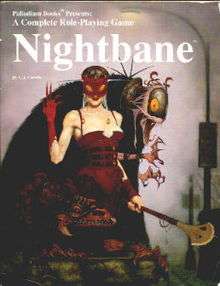Nightbane
Nightbane is a dark fantasy role-playing game and setting created by C. J. Carella and published by Palladium Books.
 Front cover of the Nightbane core rulebook, illustrated by Gerald Brom | |
| Designer(s) | C. J. Carella, Kevin Siembieda, Irvin Jackson, Kevin Hassall, Mark Oberle, Jason Vey |
|---|---|
| Illustrator(s) | Wayne Breaux, Jr., Gerald Brom, Kent Burles, Fred Fields, Scott Johnson, Vince Martin, Martin McKenna, Ramón Pérez, Roger Peterson, Randy Post, John Zeleznik, et al. |
| Publisher(s) | Palladium Books |
| Publication date | August 1995 |
| Years active | 1995–present |
| Genre(s) | Dark fantasy, horror, superhero |
| Language(s) | English |
| System(s) | Megaversal |
| Website | palladiumbooks |
Description
The game was originally published as a 240-page softcover book in 1995, designed by Carlos J. Martijena-Carella with Kevin Siembieda. Interior art was by Vince Martin, Randy Post, Scott Johnson, and Roger Peterson, with cover art by Gerald Brom. Originally published under the title Nightspawn, the game's name was changed to Nightbane after legal threats from the lawyers of Todd McFarlane, creator of the Spawn comic book.
The world of Nightbane is a modern dark urban fantasy in which a secret cabal of supernatural beings from another dimension called the Nightlords and their shapeshifting minions have quietly seized control of the world's governments and corporate powers. The only beings standing in their way are the beings known as Nightbanes created by the players. The game uses Palladium's Megaversal system, which is also used by the multi-genre game Rifts and the horror game Beyond the Supernatural, among others.
Some critics have noted strong similarities between Nightbane and the works of horror author Clive Barker, particularly the novella Cabal (1988) and its film adaptation Nightbreed (1990).[1]
After it had been out of print for some years, the property was revived by Palladium in 2009 with the release of the Nightbane Survival Guide written by Irvin Jackson and Mark Oberle.
Setting
On March 6, 2000, at 6:02am, the world was shrouded in unnatural darkness caused by an alien race known as the Nightlords. Thousands of people suddenly transformed into monsters, but when the darkness left, they returned to human form. These shape-changers, called the Nightbane, have the ability to change to their monstrous form.
Players create and play Nightbanes in order to battle the Nightlords and hopefully defeat them.[2] Characters take on normal human form (called "The Facade") until they want to transform into their horrific monstrous form. The Nightbanes are organized into various underground factions called the Resistance.[2]
Gameplay
Character creation
Players roll dice to create eight basic attributes. Using formulas, these attributes are used to attempt tasks and engage in combat. For the monstrous shape, players are able to design the monster by combining animal features, alien physiology and machine parts. Players can then add everyday skills to the character or try supernatural skills, before adding a complement of weapons and other equipment.[2]
Magic
The magic system is adapted from Beyond the Supernatural, and includes more than 130 spells.[2]
Psychic abilities
Character with enough Psychic Energy points can invoke powers such as levitation and telepathy.[2]
Changing between facade and nightbane
When a character is in its Facade (human) phase, it can shape-shift to its monstrous phase in a single 15-second round.[2]
Reception
In the March 1996 edition of Dragon (Issue 227), Rick Swan found the rules system of the original edition "dense" and "stodgy", calling the combat rules "a series of math problems based on Structural Damage Capacity (S.D.C.) and a host of modifiers" and "a pain in the neck." However, Swan loved the monster creation rules, which allowed him to design "a bat-winged humanoid toad whose skin was covered with razor blades." A disappointment to Swan was that "the book doesn't provide much in the way of adventures." He concluded by giving the game an average rating of 4 out of 6, saying, "Richly imagined, exorbitantly detailed, Nightspawn [Nightbane] is like a splatter film designed by philosophy majors; its a cheesy, brainy delight."[2]
Reviews
- Shadis #24 (Feb., 1996)
Sourcebooks
- Nightbane World Book One Between the Shadows, second printing August 1998
- Nightbane World Book Two: Nightlands, second printing October 1999
- Nightbane World Book Three: Through the Glass Darkly, first printing March 1997
- Nightbane World Book 4: Shadows of Light, first printing April 2003
- Nightbane Survival Guide, first printing July 2009
- Nightbane Dark Designs, first printing 2017
References
- Parsons, Zack; Sumner, Steve "Malak" (2013-01-24), Palladium's Nightbane, retrieved 2019-08-03
- Swan, Rick (March 1996). "Roleplaying Reviews". Dragon. TSR, Inc. (227): 111–112.
External links
- Nightbane official discussion board at Palladium Books Forums of the Megaverse
- Nightbane at RPG Geek Database
- Nightbane at RPGnet Game Index